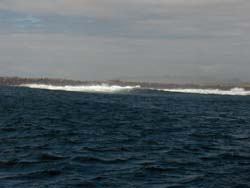

|
|
|
|
|
|
|
|
 |
Mustang Sally
|
 |
||||||||
|
||||||||||
Getting Passed the Bars
Tidal
bars are shallow accumulations
of silt and sand that naturally occur at the entrance to some of the
rivers and harbours in north eastern Pacific. Americans call this
area the Pacific Northwest - but that is a misnomer. The bars seem
to be built up when the Pacific Ocean storms and river flows deposit
sand and silt near the river entrances.
When the water of the deep Pacific
Ocean (hundreds or thousands of feet) meet the shallow bars (at tens
of feet) upwelling occurs that causes the surface waters to confused
and choppy. When river and/or tidal currents flow from a harbour
area toward the ocean, there is resistance to the flow that causes
waves to build up. The resistance causes the waves to get bigger
and start breaking - like the waves you see in surfer movies.
Below are a couple of pictures of the Umpqua River Bar. Believe it or not, these pictures show the bar when it is opened .  
Left is a picture of the safe water at Umpqua River. The nasty stuff above builds up on the north side of the channel, but under the right conditions, you can sail by on the south side.
Breaking waves are dangerous to small boats. The waves can be as big as the boat and make steering impossible. The waves can swamp the boat. The waves can cause the boat go out of control and turn over or broach and sink.
When the water is shallow as it
tends to be over the bars, the waves can be bigger than the
water is deep. That can expose the ocean floor. I hate it when
that happens.
This is a link to a some pictures
of the Columbia river bar
acting up. The pictures are from the Columbia River Bar
Pilots Association web site.
It is
amazing to come in from a relatively calm ocean and find that on
the bar the water is being really nasty. You are tired from
sailing, it is the end of the day and you are not as sharp as
you should be. You expect to come to shore where you are safe
and can relax.
But if you have to cross the bar, you can't relax.
Navigation controls need to be turned up to max and you need to
be very careful. Know exactly where you are and where you
are going. Watch the depth sounder and compare to
soundings. Monitor chart plotters/navigation systems.
Use what ever tools you have to monitor your position.
Strong currents will work to carry you off your charted course
into even shallow waters or on to one of the many submerged
breakwaters. Here are five rules to help pass a bar safely:
Looking from the ocean side you see the backs of the waves and you can not see them break. So the bar is going to be rougher than it looks. From the shore side, however you can see the waves and know better what conditions are. If in any doubt, call the local coast guard on your VHF and/or listen to the bar reports on the local Wx channels. Be prepared for the bar at your destination to be closed. You should have alternative plans. So all
this adds to the planning complexity for a harbour hopping
strategy for sailing south down the West Coast of North America.
Still if you have time and can wait and you have the flexibility
to do the odd overnight jaunt, the harbour hopping
approach seems to work just fine.
|